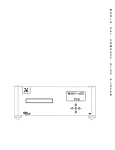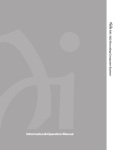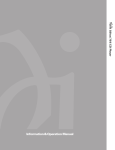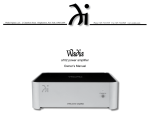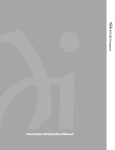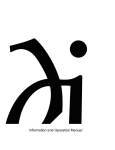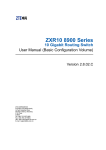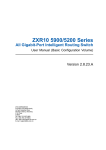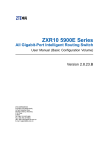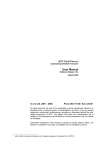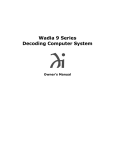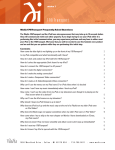Download Wadia 381i Specifications
Transcript
381/381i CD Player Information&Operation Manual 381/381i CD Player 381/381i CD Player Information&Operation Manual Table of Contents Preliminaries Wadia Digital – A Brief History . . . . . . . . . . . . . . . . . . . . . . . . . . . . . . . . . . . . . . . . . . . . . . . . . . . . . . . . . 3 Installation and Set-up Unpacking . . . . . . . . . . . . . . . . . . . . . . . . . . . . . . . . . . . . . . . . . . . . . . . . . . . . . . . . . . . . . . . . . . . . . . . . . . . 4 Accessories . . . . . . . . . . . . . . . . . . . . . . . . . . . . . . . . . . . . . . . . . . . . . . . . . . . . . . . . . . . . . . . . . . . . . . . . . 4 Installing the Tip-Toes . . . . . . . . . . . . . . . . . . . . . . . . . . . . . . . . . . . . . . . . . . . . . . . . . . . . . . . . . . . . . . . . 4 Connecting to Your System . . . . . . . . . . . . . . . . . . . . . . . . . . . . . . . . . . . . . . . . . . . . . . . . . . . . . . . . . . . . 4 Connecting to AC Power . . . . . . . . . . . . . . . . . . . . . . . . . . . . . . . . . . . . . . . . . . . . . . . . . . . . . . . . . . . . . . 5 Connecting Directly to a Power Amplifier . . . . . . . . . . . . . . . . . . . . . . . . . . . . . . . . . . . . . . . . . . . . . . . 5 Using with a Preamplifier . . . . . . . . . . . . . . . . . . . . . . . . . . . . . . . . . . . . . . . . . . . . . . . . . . . . . . . . . . . . . 5 Optimizing the Output Level . . . . . . . . . . . . . . . . . . . . . . . . . . . . . . . . . . . . . . . . . . . . . . . . . . . . . . . . . . . . 6 Connecting Digital Sources (Wadia 381i CD Player only) . . . . . . . . . . . . . . . . . . . . . . . . . . . . . . . . . . 6 Choosing a Digital Cable (Wadia 381i CD Player only) . . . . . . . . . . . . . . . . . . . . . . . . . . . . . . . . . . . . . 6 Frequently Asked Questions . . . . . . . . . . . . . . . . . . . . . . . . . . . . . . . . . . . . . . . . . . . . . . . . . . . . . . . . . . . 7 General Operation Front Panel Controls . . . . . . . . . . . . . . . . . . . . . . . . . . . . . . . . . . . . . . . . . . . . . . . . . . . . . . . . . . . . . . . . . . 8 Display Features . . . . . . . . . . . . . . . . . . . . . . . . . . . . . . . . . . . . . . . . . . . . . . . . . . . . . . . . . . . . . . . . . . . . . 9 Display Functions . . . . . . . . . . . . . . . . . . . . . . . . . . . . . . . . . . . . . . . . . . . . . . . . . . . . . . . . . . . . . . . . . . . . 9 Disc Formats . . . . . . . . . . . . . . . . . . . . . . . . . . . . . . . . . . . . . . . . . . . . . . . . . . . . . . . . . . . . . . . . . . . . . . . .10 Remote Control Operation . . . . . . . . . . . . . . . . . . . . . . . . . . . . . . . . . . . . . . . . . . . . . . . . . . . . . . . . . . . .11 Playback Options . . . . . . . . . . . . . . . . . . . . . . . . . . . . . . . . . . . . . . . . . . . . . . . . . . . . . . . . . . . . . . . . . . . .13 Theory of Operation . . . . . . . . . . . . . . . . . . . . . . . . . . . . . . . . . . . . . . . . . . . . . . . . . . . . . . . . . . . . . . . . . .14 Menu Screen Map . . . . . . . . . . . . . . . . . . . . . . . . . . . . . . . . . . . . . . . . . . . . . . . . . . . . . . . . . . . . . . . . . . .16 Digital Algorithms . . . . . . . . . . . . . . . . . . . . . . . . . . . . . . . . . . . . . . . . . . . . . . . . . . . . . . . . . . . . . . . . . . . .17 Appendices Troubleshooting . . . . . . . . . . . . . . . . . . . . . . . . . . . . . . . . . . . . . . . . . . . . . . . . . . . . . . . . . . . . . . . . . . . . .18 Using Data Discs . . . . . . . . . . . . . . . . . . . . . . . . . . . . . . . . . . . . . . . . . . . . . . . . . . . . . . . . . . . . . . . . . . . .18 Software License Agreement . . . . . . . . . . . . . . . . . . . . . . . . . . . . . . . . . . . . . . . . . . . . . . . . . . . . . . . . .18 Environmental Care . . . . . . . . . . . . . . . . . . . . . . . . . . . . . . . . . . . . . . . . . . . . . . . . . . . . . . . . . . . . . . . . . .18 Technical Specifications . . . . . . . . . . . . . . . . . . . . . . . . . . . . . . . . . . . . . . . . . . . . . . . . . . . . . . . . . . . . . .19 Safety Precautions . . . . . . . . . . . . . . . . . . . . . . . . . . . . . . . . . . . . . . . . . . . . . . . . . . . . . . . . . . . . . . . . . . 20 2 Thank You All of us at Wadia would like to offer thanks and congratulations to you for purchasing the Wadia 381/381i CD Player. We sincerely believe that your Wadia 381/381i CD Player will bring you many years of musical pleasure and satisfaction. While every new owner is anxious to begin listening, we encourage you to take a few minutes to read this manual and familiarize yourself with the full capabilities of the Wadia 381/381i CD Player. If you are in a hurry to begin listening, please read the sections of this manual where the symbol at right is shown. ! Wadia Digital – A Brief History Wadia Digital, founded in 1988, is one of the original companies dedicated to high performance digital audio reproduction. Wadia was formed by a team of engineers from the Minneapolis based 3M Corporation (Minnesota Mining and Manufacturing) who shared many years of experience in advanced digital telecommunications research and development. In the early 1980’s, these engineers became intrigued by the emerging compact disc technology. Disappointed with the sound quality of early CD players, they examined the workings and designs of these early components and found them to be unsophisticated when compared with the technology available in other areas of digital design. In response, they founded Wadia Digital – a company based on the philosophy of applying advanced technology to improve the performance of digital audio components. Wadia’s first product, the Wadia 2000 Decoding Computer, was an absolute breakthrough in digital audio. For many discerning listeners, it proved that Digital Audio was a musically responsive, evolving, and engaging format. Building on a tradition of excellence, Wadia continues to develop innovative technology; refining, listening, engineering, and improving along the way. Since the Wadia 2000, new generations of industry-leading designs have been introduced and embraced by listeners around the world. Each step of the way, Wadia has consistently raised the standard for performance of Digital Audio playback. Here is a brief list of the technological innovations the Wadia engineers have pioneered over the past 20 years: • DigiMaster™ patented algorithm (filter optimized for reproducing music) • ClockLink™ proprietary jitter reduction technology • SwiftCurrent™ current to voltage conversion technology • First outboard Digital-to-Analog converter • First to apply glass fiber-optics to home audio • First to recognize jitter as a source of audible distortion • First to perfect digital volume control • First high-end CD player competitive with expensive separates • First company to provide bit perfect digital audio output from the iPod Although Wadia’s digital expertise and track record exceed those of any audio company, technology alone does not guarantee musical performance. Wadia designs are born of a delicate balance of technology shaped by a passion for music. Wadia is proud to introduce the Wadia 381/381i CD Player, a breakthrough in sonic performance and value, and a strong statement of our years of dedication to music. 3 381/381i CD Player Installation and Set-up Unpacking Use care in unpacking your Wadia 381/381i CD Player. Inspect it for any shipping damage and call your dealer immediately if any is found. ! Do not plug your Wadia 381/381i CD Player into an AC outlet if you find shipping damage. We advise saving all packing materials so that the unit can be easily and safely shipped if the need arises. Accessories Provided with the Wadia 381/381i CD Player are the following accessories: • AC power cord • Four tip-toes with threaded studs • Four steel coasters • RCA/BNC adapter (only included with 381i CD Player) • Remote Control • Two type AAA batteries ! Do not tip the unit onto the back panel. This can damage input and/or output connectors. Installing the Tip-Toes With the unit still positioned on its side, screw one of the tip-toes into the bottom of each corner post. Position the Wadia 381/381i CD Player where you would like it to reside in your system. We recommend choosing a solid, non-resonant, level surface for best performance. If this surface is susceptible to damage, place one of the steel coasters under each tip-toe. 4 Connecting to Your System CHECK VOLTAGE HERE ! Check to make sure your Wadia 381/381i CD Player has been manufactured for operation at your AC line Voltage. Attempting to use the Player at any voltage other than the specified on the rear of the unit may damage the unit. Damage caused by improper operation is not covered by warranty. If the voltage specified is different from your AC voltage, contact your Wadia dealer. ! Connecting to AC Power We have designed your product with careful attention to every detail. We are extremely confident of the performance obtained when your Wadia component is plugged directly into the wall with the power cord provided. Your Wadia product has been designed with power conditioning, surge suppression and an extremely sophisticated overall protection scheme. Externally sourced surge protectors, power conditioners, or aftermarket power cords can be a mixed bag of benefits and limitations, particularly those which limit current and/or alter phase relationships of the voltage and current (power factor) delivered to the Wadia product. In some cases, we have found aftermarket products can be quite beneficial, while in other cases we have found that these products can actually degrade the sonic performance. If you wish to experiment with any of these devices, work closely with your local dealer – and most of all, trust your own ears. Connecting Directly to a Power Amplifier Avoid allowing static shocks to be applied to the inputs or outputs. To prevent static shocks, touch any grounded surface, such as the Wadia 381/381i CD Player chassis, before connecting or removing a cable. It is unlikely that a static shock will damage the unit, but it may cause the Wadia 381/381i CD Player circuitry to “lock-up” (see Trouble Shooting: Lock-Up in the Appendices). Inputs and outputs can be safely connected to the Wadia 381/381i CD Player 1. Before the unit is powered up 2. When the unit is in Relay-Mute mode We strongly recommend that you use your Wadia 381/381i CD Player connected directly to your power amplifier. Even if you purchased your Wadia 381/381i CD Player with the intention of connecting it to your preamplifier, we suggest that you try direct connection to your amplifier. Many listeners are surprised by the improvement in performance over even the most expensive preamplifiers. To connect your Wadia 381/381i CD Player to a power amplifier, ensure that your power amplifier is turned off then connect your analog interconnects from the Wadia 381/381i CD Player analog outputs to the amplifier’s inputs. Using with a Preamplifier While the Wadia 381/381i CD Player was designed to be used without a preamplifier, no compromises were made in its design that will prevent excellent operation in a conventional system with a preamplifier. When using a preamplifier, set the Wadia 381/381i CD Player volume control to its maximum level. 5 381/381i CD Player Optimizing the Output Level Best performance is obtained when operating the Wadia Volume Control near the top of its range. If needed, the maximum output level of your Wadia 381/381i CD Player can be adjusted to match the overall sensitivity of your system so that the critical listening will take place with the volume control operating near the top of its range. The maximum output level of the Wadia 381/381i CD Player is adjustable by means of a set of internal switches. The Wadia 381/381i CD Player is factory set to accommodate the most common range of system sensitivity. If you find that your typical volume level during critical listening is below 65 on the volume display, it will be advantageous to use a different setting. To change the output level, consult your dealer. Connecting to Other Digital Sources (Wadia 381i CD Player only) The Wadia Integrated CD Player /Decoding Computer is equipped with digital inputs which can accept digital signals from any of these established digital formats. (Input 1: Wadia USB, Input 2: Coaxial with BNC connector, Input 3: Plastic-optical TOSLINK, Input 4: AES/EBU with XLR connector). The Wadia Integrated CD Player /Decoding Computer digital inputs will decode any word length up to 24-bit, and any of the standard digital audio sampling frequencies up to 96kHz. Choosing a Digital Cable (Wadia 381i CD Player only) The performance of any digital transmission method depends on the quality of the cable and the sophistication of the transmitter and receiver. For example, a high quality coaxial cable can outperform a low quality AES/EBUcable. A high quality AES/EBU cable will outperform a poorly implemented glass optical system. If you are using a coaxial cable we recommend that you have the cable terminated with a BNC connector. This will provide higher performance than an RCA connector. Your Wadia Integrated CD Player /Decoding Computer comes with an RCA/BNC adapter that can be used for experimentation between different types of coaxial cable. Please note that USB cables from different manufacturers can exhibit a broad range of performance levels. Regardless of manufacturer, the length of USB cable can affect sound quality in significant ways, with shorter lengths always sounding better than extremely long lengths. Again, we highly recommend that you take advantage of your dealer’s experience and, most importantly, trust your ears. All XLR-type inputs and outputs on the Wadia 381/381i CD Player, both digital and analog, use the standard audio pin configuration: Pin 1 - Ground Pin 2 - Positive signal Pin 3 - Negative signal 6 Frequently Asked Questions Should I use a Balanced or Unbalanced connection? If your amplifier has a true balanced input, we recommend you use the balanced analog output from your Wadia 381/381i CD Player. All things being equal, properly implemented balanced (also called differential) circuitry sounds better than unbalanced circuitry. The Wadia 381/381i CD Player is a true balanced design. It generates the inverted signal in the digital domain and all subsequent processing is done in balanced mode. Your Wadia 381/381i CD Player is designed to maintain many of the advantages of true balanced design when using the unbalanced outputs. In addition, the Wadia 381/381i CD Player output stage is capable of driving both types of outputs simultaneously. Why should I bypass the Preamplifier? A preamplifier is unnecessary when using your Wadia 381/381i CD Player. The Wadia 381/381i CD Player provides all the necessary control functions of a preamp while the signal is still in the digital domain. This avoids the sonic degradation caused by analog circuitry, switches, and wire. The Wadia 381/381i CD Player output stage can drive any power amplifier and any interconnects, even at very long lengths. Does the Wadia Volume Control compromise resolution? The Wadia 381/381i CD Player uses the latest generation of Wadia’s proprietary digital volume control. The volume level can be varied in the digital domain by means of mathematical manipulation of the signal, eliminating the distortion and noise that are inevitable with even the best analog volume controls. While conventional thinking indicates that reducing the volume digitally can sacrifice low level resolution, Wadia has created an innovative solution. Wadia’s patented digital filtering algorithm produces a 24 bit output rather than the 16 bits stored on the CD. This high-resolution signal is then used in the computations which in turn reduce the volume level. This new signal is fed directly to the DAC chips. Through this innovative method, the Wadia 381/381i CD Player maintains high resolution even at the lowest volume control settings. Can I bypass the Wadia Volume Control? Because the Digital Volume control does not include any analog circuitry, there is none to be bypassed. Even the mathematical program step that performs the Digital Volume Control calculation is an integral part of the Wadia DigiMaster filter algorithm and therefore cannot be bypassed. If you do not need the Wadia Volume Control, set it to its maximum level of 100 on the display. What about Analog Sources? In order to fully realize the potential of this type of system, Wadia has a range of Analog-to-Digital converters. Now it is possible to use analog sources, such as a tuner, tape deck, or even a turntable (in conjunction with a suitable phono stage) in your system without using a conventional analog preamplifier. Consult your dealer for more information on the Wadia Analog-to-Digital products. Should I leave the Wadia 381/381i CD Player with the power on? The Wadia 381/381i CD Player is designed to be left with the power on with no harm or wear to the unit. All motors and laser circuitry turn off when the unit stops playing. If desired, the front display can be turned off (see Turning off the Display under Remote Operation). Leaving the power on allows the circuitry to remain in thermally stable, which provides better performance and longer life. Careful listeners will notice that the sound of the Wadia 381/381i CD Player will improve steadily after the unit is powered up. A new unit will undergo more dramatic changes when power is applied for the first time. If you turn off your Wadia 381/381i CD Player for more than an hour, you will find that the unit will undergo similar, but less dramatic improvement once power is reapplied. 7 381/381i CD Player General Operation Using the switch located directly above the AC power input, turn the switch to the ON position. Front Panel Controls The front panel of the Wadia 381/381i CD Player features basic controls that allow you to operate basic functions without using the Remote Control. Volume Up Increase the volume by 1/2 dB. Play/Next Track This button will cause the unit to advance to the next track and begin playing. Previous Track This button will cause the unit to move to the previous track and begin playing. Open/Close/Stop If the drawer is open, pushing this button will CLOSE the drawer. If the CD is playing, pushing this button will STOP playing. If the unit is not playing, pushing this button will OPEN the drawer. Example: To open the drawer while the unit is playing, push the button once to stop and once more to open. 8 Volume Down Decreases the volume by 1/2 dB. Display Features Track Time Playback Options Volume Format Transport Functions Display Functions The Wadia 381/381i CD Player features a large display screen. The top section shows the status of the transport. The bottom of the display indicates preamp functions, as described below. Turn-On Screen This screen is displayed each time the Wadia 381/381i CD Player is powered-up. After five seconds, the display will change to the Input screen with internal transport selected, then change again to the Volume screen with the volume set to Zero. (The screen on the 381i CD Player will read “381i CD Player”) 381 CD Player Input Screen The Input screen shows which input is currently selected. It also indicates whether ClockLink is engaged and the sampling frequency. If there is no signal connected to the selected input, the display will read, “No Data.” I n 1 : U S B A u d i o 9 381/381i CD Player Status Screen The Status screen indicates whether the status is Phase Normal or Inverted, and whether the CD was recorded using digital high frequency emphasis. Volume Screen The Volume screen shows the right and left channel volume level. If the output is muted, the display will indicate this by showing, “MUTE.” During normal listening, the display will show the default screen Changing Between Display Screens Anytime a button is pressed, the Wadia 381/381i CD Player display automatically switches to the appropriate screen to display the change. For example, pressing the balance controls on the remote control will switch the 381/381i CD Player display to the Balance screen. After five seconds, the display will return to the Volume screen. Also, pressing the enter button will cause the display to change to the next screen. Repeatedly pressing the enter button will cause the display to continue to change to successive screens (see the Menu Screen Map on page 16). Disc Formats The 381/381i CD Player will not only play CD's recorded in the Red Book CD standard (including CD-R and CD-RW), but it also can play discs recorded in several of the other popular formats: MP3, FLAC and WMA. The 381/381i CD Player will display the file format in the upper right hand corner of the display panel. If a disc with multiple formats (hybrid disc) is inserted, then the 381/381i CD Player will display HYBD. When you first load a MP3, FLAC or WMA encoded disc you will see the total track count along with a disc time of “00:00”. When the 381/381i CD Player is playing data discs, the user may skip tracks front and back with direct track access, using the number pad on the remote, available up to track 999. In addition, the time display options become non-operational, the 381/381i CD Player will only display the time played on the track, not the time remaining for the track or the whole disc. 10 L R display Display On-Off phase enter input Input program mode 1 2 3 4 5 6 7 8 9 Search Back M M 0 M M Search Forward Stop / Volume Up I M Play M M mute M M S Remote Control Operation The Wadia 30 Key Remote Control requires two type-AAA batteries, which you will find in the accessories kit. To install the batteries, remove the battery cover on the back of the remote by sliding it towards the bottom of the remote. Insert the batteries as indicated on the battery holders. Balance Left-Right SS Key Pad Drawer Open-Close S Track Back / Mute S Program / Mode M Phase Invert / Enter Repeat S Track Forward Volume Down / Pause Volume – /+ Whenever the volume control buttons are pressed, the volume for both channels will be increased or decreased by an increment of 1 on the display screen. The range of the volume control is from 0 to 100, with each step representing 0.5 dB change in volume. R Balance L Relative volume of each channel can be adjusted via the balance control buttons on the remote. Pressing one of the balance buttons increases the volume on that channel relative to the other by an increment of 0.2 on the display. This corresponds to a 0.1dB change. The next time the button is pressed the opposite channel is decreased. This way the overall volume level (the sum of the two channels) remains constant within 0.1 dB. Input Inputs can be selected from the remote control by pressing the input button. Each time the input button is pressed, the next input is selected. For example, if you are listening to Input 1 and you press the input select Input 2 will be selected, press it again, and Input 3 will be selected and so on. After the last input has cycled through, the list will begin again with the internal drive. Whenever you select a new input, the display will switch to the Input Screen. 11 381/381i CD Player Phase Invert All Wadia Players have the ability to invert absolute phase in the digital domain. Pressing the Phase button on the remote control will cause the Player to invert phase; pressing it again will switch the phase back to normal. If the Player is in Phase Invert mode, this will be indicated on the Input Screen of the display. Display On/Off By pressing the Display button, the Player can be turned either on or off. When the display is off, each remote command will cause the display to light up momentarily. Mute Modes There are two mute modes that are automatically implemented under certain circumstances. DSP -Software Mute When the Mute button is pressed on the remote control, the Player’s DSP engine transmits a stream of zero signal level samples to the DAC section, which results in zero output. Output Relay Mute There is a mute relay connection between the positive and negative outputs, when this relay is engaged, it connects the positive output to the negative output, reducing the output to zero. This relay, which produces an audible click when it engages or disengages, is not in the music signal path. The mute relay is engaged: • When the Player detects AC input level below its minimum operating range. • Each time the Player’s power switch is turned on. • When the volume control is set to zero AND the mute button on the remote control is pressed. When the Player is in either Mute Mode, the Volume Screen will indicate this by displaying the word, “MUTE.” TRACK BACK/FORWARD : Pressing these buttons allows access to the previous or next track on a CD. SEARCH BACK/FORWARD : Pressing these buttons allows fast reverse or fast forward access through a track. Pressing the PLAY button to resumes normal playback. STOP : Pressing this button while a CD is playing stops PLAY. PAUSE : Pressing this button, while a CD is playing, suspends PLAY. Pressing PAUSE again will allow playback to continue. PLAY : After a CD has been loaded, pressing this button plays the CD beginning with the first track REPEAT : This button controls two repeat modes: Repeat track and repeat all. Pressing the button once will cause the individual track to repeat. Pressing the button a second time will cause the entire CD to repeat continuously. A third button press returns the system to “no repeat” mode. 12 TRACK BACK/FORWARD : Pressing these buttons allows access to the previous or next track on a CD. SEARCH BACK/FORWARD : Pressing these buttons allows fast reverse or fast forward access through a track. Pressing the PLAY button to resumes normal playback. STOP : Pressing this button while a CD is playing stops PLAY. PAUSE : Pressing this button, while a CD is playing, suspends PLAY. Pressing the PLAY button will resume play at the point where the pause button was pressed. PLAY : After a CD has been loaded, pressing this button plays the CD beginning with the first track Playback Options TIME : This button switches between the various time modes on the display. Before play, the total time on the CD is shown. Once a CD starts to play the elapsed time of that track will be shown. Pressing the button on the remote control once will cause the display to indicate the remaining time in that track (remain). Pressing this button on the remote control again will cause the display to indicate the total time elapsed for the entire CD. Pressing the button another time will cause the display to show the total time remaining for the entire CD. Finally, pressing the button again will cycle back to the original default setting. Note: When the 381/381i CD Player is playing MP3, FLAC, or WMA encoded discs the time display options become non-operational. The 381/381i CD Player will only display the time played on the track. REPEAT : Pressing this button will cause the entire CD to repeat continuously. Pressing this button a second time will take the transport out of the repeat mode. SINGLE REPEAT : Pressing this button will repeat a single track continuously. Pressing the single repeat button a second time will take the transport out of single repeat mode. 13 381/381i CD Player Theory of Operation Using ClockLink with an External Processor ClockLink eliminates jitter added when the clock signal is recovered from the digital data stream. In a non-ClockLink system, jitter is added when the clock signal is embedded in the data stream and transmitted to the DAC. When the clock signal is recovered from the data stream (as shown below), and used to clock the DAC output, this jitter degrades the sonic performance. Data and Clock to DAC Transport DAC Jitter Added Conventional CD Player With ClockLink, the clock is not recovered from the data. Instead, the master clock is located at the DAC. This clock signal is transmitted to the transport to keep it synchronized with the DAC. Because the recovered clock is ignored, any jitter on that signal does not affect the sonic performance. Data to DAC Transport DAC Clock to Transport CD Player with ClockLink The Wadia 381/381i CD Player with its digital inputs and outputs can be used with a digital signal processor such as a digital equalizer. Digital processors allow the signal to be modified without adding analog noise and distortion. However, digital processors can add jitter, as shown below, causing noticeable sonic degradation. Data and Clock to DAC Digital Output Digital Processor Jitter Added Transport Digital Input DAC Conventional CD Player with an External Digital Processor Using ClockLink with an external processor, the Wadia 381/381i CD Player ignores the incoming clock and uses the master oscillator at the DAC. As a result, jitter added by the external digital processor does not affect sonic performance. Data to DAC Digital Output Digital Processor Digital Input Transport DAC Clock to Transport CD Player with ClockLink with an External Digital Processor 14 Configuring Digital Inputs for ClockLink (Wadia 381i CD Player Only) To utilize ClockLink with an external processor, the Wadia 381i CD Player digital inputs must be configured for ClockLink as described below. Use the Enter button to scroll through the display menus until you reach the configuration menu for the input you wish to configure. Shown below is the configuration menu for Input 1: Use the Volume Up or Volume Down button to change to ClockLink ON. Press the Mute button to save the configuration. Note: Using ClockLink with a source other than the internal transport will result in unpredictable, degraded performance. ! ClockLink should only be used when using an external processor which is being fed by the 381i CD Player internal transport. For all other applications, inputs should be configured with ClockLink OFF. The Wadia 381i CD Player has several features to prevent ClockLink from being engaged when it should not be. First, whenever the input signal is other than 44.1 kHz sampling frequency, the Wadia 381i CD Player will automatically revert to recovered clock mode. Second, if the internal transport is not running, the Wadia 381i CD Player will revert to recovered clock mode. Note: All inputs on the Wadia 381i CD Player are factory configured for ClockLink OFF. ! ClockLink Status Indication When the Wadia 381i CD Player is operating in ClockLink mode, the Input screen will indicate as shown below: I n 1 : U S B A u d i o Even if an input is configured for ClockLink, the Status screen will only indicate ClockLink if it is currently engaged. For example, if an input is configured for ClockLink, and the Wadia 381i CD Player’s internal transport is turned off, then the display will not indicate ClockLink. 15 381/381i CD Player Menu Screen Map Volume Screen Enter Enter Status Screen Operation Screens Balance Screen Enter Input Screen Enter Mute Enter Mute Enter Mute Mute Enter Mute Enter Y+Enter N+Enter 16 Configuration Screens Enter Digital Algorithms In the Wadia 381/381i CD Player there are three user-selectable digital algorithms that can be used to optimize the sonic performance based on system matching and personal musical priorities. The three algorithms in the 381/381i CD Player all upsample to 32x the input rate (at 24 bit/1.4112 MHz DAC sample rate), but differ in their time and frequency domain characteristics. They are: Algorithm A Digimaster v2.5. Wadia’s classic time-domain interpolation algorithm delivers a robust sound with extraordinary image Focus and re-creation of recorded space. Algorithm B Provides a more extended top end than Algorithm A, with superior time-domain performance compared to conventional CD filters. Algorithm C Retains the high frequency extension and superior detail resolution of Algorithm B, but with a more relaxed presentation overall. The selected algorithm is used for 44.1 kHz (CD) and 48 kHz sources, either from the internal transport or any of the four digital inputs. For 88.2 kHz and 96 kHz sources, Digimaster v2.5 is always used as it provides the best performance at high-sample rates. We encourage you to become familiar with the unique sonic performance of each of these algorithms and enjoy the one that brings you optimum musical pleasure. Selecting an Algorithm To change the digital processing algorithm, press the Enter button on the remote control repeatedly to bring up this configuration screen: The selected algorithm is shown on the second line of the display. Use the Up and Down Volume buttons to scroll to the desired algorithm, then either press the Mute button or the Enter button to navigate to the ‘Save Changes?’ screen and choose ‘Yes’. The display will indicate ‘CONFIGURATION STORED’ and the output of the 381/381i CD Player will mute for 5-10 seconds while the selected algorithm is downloaded to the two DSP computers. Performing an Algorithm Comparison When comparing processing algorithms it is important to adjust the volume to compensate for the different gains of the algorithms. Without this adjustment the one which is louder will usually sound better in a short-term A/B comparison. In the 381/381i CD Player, algorithm A is approximately 1db higher output level than B and C (which are within 0.1 db of each other). To compensate for this higher output level, increase the indicated volume setting by 2 units for algorithms B and C when comparing them to A. 17 381/381i CD Player Appendices TroubleShooting: Lock-up If the Wadia 381/381i CD Player experiences a powerful static shock or sudden AC surge, it is possible to “lock-up” the computer circuitry. A locked-up computer may result in erratic display, no output, and no response to remote commands. If your Wadia 381/381i CD Player should lock-up, unplug the AC cord. Wait at least 30 seconds before replugging in the unit. If the unit still does not operate normally, contact your dealer. Using Data Discs We have noticed when making FLAC discs for the 381/381i CD Player with Microsoft Vista, you need to use a third party CD burning program (ie: Easy CD Creator, Media Monkey). If you use Vista’s CD burning software, the CD is not properly closed so the 381/381i CD Player cannot read the files. We have not experienced any issues with Windows XP making FLAC data CD’s. We have also found no issues with a MAC OSX making the burn. The 381/381i CD Player will accept FLAC files up to 24/96 sample rates. Software License Agreement IMPORTANT! THIS AGREEMENT SETS FORTH TERMS AND CONDITIONS FOR THE DigiMaster SOFTWARE. The DigiMaster software is copyrighted and patented. It is the property of Wadia Digital. Title to Licensed Software is not transferred to the customer. The customer is granted a nonexclusive license to use the Licensed Software only on this Wadia 381/381i CD Player. At Wadia’s sole Discretion, Wadia may provide customer with updates of the Licensed Software. Wadia retains the right to provide the Licensed Software updates for a fee. The customer may refuse to accept such Licensed Software updates. Environmental Care Wadia makes every effort to be an environmentally conservative company. We appreciate it if our customers join our efforts. Please dispose of batteries in a manner that is environmentally responsible. 18 Technical Specifications Decoding Software 3 user selectable upsampling algorithms including DigiMaster v2.5 Digital Processing Capability 1 - 24 Bits Digital Resolution 21 Bits Compatible Formats Red Book CD, CD-R, CD-RW, MP3, FLAC (up to 24/96) and WMA (will not play WMA lossless) Analog Outputs One pair of Balanced (XLR); One pair of Unbalanced (RCA). Both can be used simultaneously Digital Outputs (Wadia 381i only) 1 - Glass Fiber-Optic (ST), 1 - AES/EBU (XLR), 1 - SP/DIF (BNC), 1 - Plastic Optical (Toslink) Digital Inputs (Wadia 381i only) 1 - USB (B1), 1 - AES/EBU (XLR), 1 - SP/DIF (BNC), 1 - Plastic Optical (Toslink) Output Impedance 51 ohms Power Consumption 58 watts Weight 55 lb. (25kg) Unit itself; 62 lb. (28kg) Shipping Weight Dimensions 17˝ Wide, 16.5˝ Deep, 7˝ High (including spiked feet) 19 381/381i CD Player Safety Precautions ! ! IMPORTANT SAFETY PRECAUTIONS ! To get the best performance from your Wadia 381/381i CD Player, and for your own safety, please read and follow these important safety instructions. 1 Before operating the Wadia 381/381i CD Player please read all operating and safety instructions. 2 Never place the Wadia 381/381i CD Player near heat sources such as radiators, fireplaces, stove, or other appliances that produce heat. Avoid placing the Wadia 381/381i CD Player where it will be subject to direct sunlight or low temperatures. 3 This product is equipped with a three prong AC power cord which includes an earth ground connection. To prevent shock hazard, all three connectors must always be used. If your electrical outlets will not accept this type of plug, an adapter may be purchased. If an adapter is necessary, be sure it is an approved type and that it is used properly, supplying an earth ground. If you are not sure of the integrity of your home’s electrical system, contact a licensed electrician for assistance. 4 AC extension cords are not recommended for use with this product. If an extension cord must be used, be sure it is an approved type and has sufficient current carrying capacity to power this product. 5 Before cleaning the Wadia 381/381i CD Player, always disconnect the power supply cord. Use a soft cloth and, if necessary, dampen with plain water. Never apply water, or any other cleaner, directly to the chassis. 6 If you smell smoke, or an abnormal smell, immediately unplug the Wadia 381/381i CD Player from the power supply and contact your Wadia dealer. 7 Unplug unit if it becomes wet. 8 Replace fuse only with the exact type originally included. 100 volt: (1) 1 amp Slo-Blo 120 volt: (1) 1 amp Slo-Blo 220 volt: (2) 1/2 amp Slo-Blo 240 volt: (2) 1/2 amp Slo-Blo 9 THERE ARE NO USER SERVICEABLE PARTS INSIDE THE WADIA 381/381i CD PLAYER! • Do not attempt to repair or modify your Wadia 381/381i CD Player. • All service should be performed by qualified service personnel. • Do not open the unit while it is attached to the AC outlet. www.wadia.com























